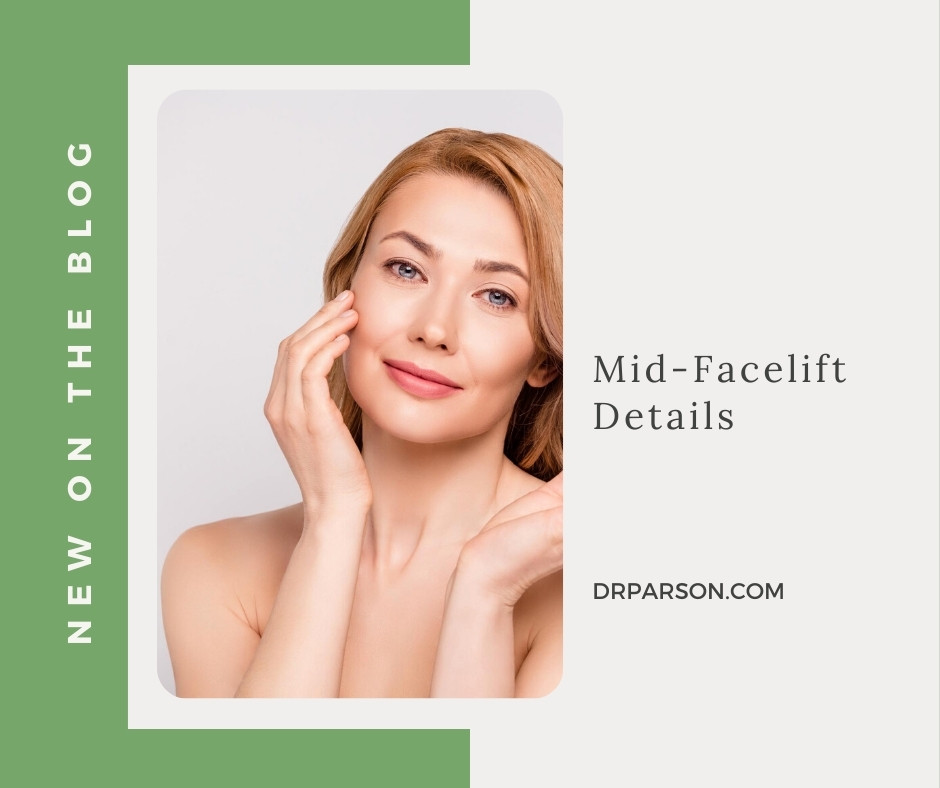
11 Aug Mid-Facelift Details
A facelift is the most well-known type of facial plastic surgery, but it’s actually an umbrella term for various types of facelifts. At Dr. Shaun Parson Plastic Surgery & Skin Center, we match you with the best procedures for you and your goals. Today’s facelifts, no matter what kind, are worlds apart from what was available even 10 years ago. The “standard” facelift today is called a full facelift, but there are even modifications within that procedure. A lesser-known approach that’s gaining traction is the mid-facelift, popular because it is less invasive and boasts a shorter recovery period than a full facelift. However, no matter what kind of facelift you get, bear in mind that it only affects the lower half of the face. If you want to lift the upper half of the face, a blepharoplasty might be a good add-on (more on that later).
Aptly named, a mid-facelift is a surgery that targets the middle area of the face, specifically right below the lower eyelids to the mouth. It targets the nasolabial folds and cheeks, two of the most common areas we first see early signs of aging. It’s important to note that, unlike a full facelift, a necklift is not included in a mid-facelift. This is part of the reason it requires less incisions and downtime. If you do notice jowling and a sagging neck, a full facelift might be for you. Those with mild to moderate signs of aging around the mid-face could be good candidates for a mid-facelift. The only way to know is to schedule a consultation with a reputable plastic surgeon.
The Mid-Facelift Candidate
Ideal patients for a mid-facelift have flattened cheek pads that make them look tired or older than they are. Nasolabial folds typically deepen, which often begins in your 40s. You’ll notice an overall lack of volume in the middle portion of the face. A mid-facelift (or full facelift) can dramatically help with this, but remember that surgeries do not restore volume. Many people opt for dermal fillers after they have healed from any kind of facelift. In fact, facelifts can get rid of folds and wrinkles but can draw attention to lost facial volume—fillers can fix that. This is another item to add onto your consultation checklist.
However, those who are nice fits for a mid-facelift also have pretty good skin elasticity. They aren’t aging or sagging much around the neck and jowls. This means they are often younger, perhaps in their late 30s or 40s. An easy way to tell if a mid-facelift might be for you is to pull your hair back in a tight ponytail. If you like how you look with your cheeks shifted slightly to your temples, that’s what a mid-facelift will do. Most of the “pull” will be toward the eyes, but you will also naturally see some improvements in the jawline with this approach. Our midface is at the core of the facial aging process, which is why mid-facelifts are one of the first facial plastic surgeries many people match with. It reverses the aging process from gravity.
Getting Ready for a Lift
A full facelift is for those with more advanced signs of aging, deeper wrinkles, and with jowls and neck sagging coupled with severe skin laxity. All full facelifts are inherently combined with a necklift (this is not considered a separate procedure), and you’re going to experience more intensive revitalization. The incision for a necklift is a tiny point right under the chin that is naturally hidden. Unlike the mid-facelift, a full facelift takes the pull vector more backwards than upwards, with incisions in and around the ears. Today’s techniques include addressing underlying tissue, which avoids the windswept look of the 90s facelift. However, it is still a risk with some patients, especially those of Asian descent. In these cases, patients might be better suited for an upwards vector for a natural look.
No matter what type of facelift you get, there will be general anesthesia, bruising, swelling, and some downtime. Most patients feel confident going about in public at least two weeks after surgery. The more incisions you have, the longer the downtime. A blepharoplasty, or eyelid lift, is a popular add-on. You can choose from an upper or lower lift, and these surgeries are quick and heal relatively quickly. It’s an ideal way to improve wrinkles around the eyes as well as sagging and bags.
Are you ready to see which kind of facial plastic surgery is best for you? Schedule a consultation with Dr. Parson by calling the office during business hours or filling out the online contact form right now.
